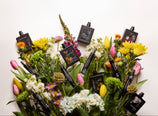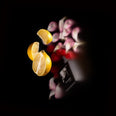Discover the Art of Listening
Growing up playing the viola in orchestra, I sometimes envied the violinists. They commanded attention with soaring melodies that dazzled in the upper registers, while my role was woven deeper into the fabric of the ensemble. As a middle voice in the orchestra, the viola rarely takes center stage, yet its warmth and depth are essential, bridging the space between bright treble and the deep foundational bass.
To be a good violist I had to become a good observer. My instrument was about nuance, not bravado, so I learned to carefully sense the interplay of harmonies, the delicate shifts of tone and color amidst the push and pull of tension and resolution. What I didn’t realize then was that this way of hearing—of perceiving details within a greater whole—would later define my approach to perfumery.
Music as an Olfactive Blueprint
Much like a symphony, a good fragrance unfolds in layers. The top notes—bright citruses, airy florals, or peppery greens—are the opening melody, the first impression that captures attention. As the fragrance evolves, deeper harmonies emerge: rich woods, soft musks, and resinous ambers are the lower voices that ground the composition.
As a perfumer, I approach scent with the same sensitivity I bring to music. I listen to how notes interact—how they blend or contrast, how one accord lifts another or how tension builds before resolving into harmony. Fragrance is an orchestration of elements that must work together, each ingredient chosen not just for its beauty or unique quality, but for the way it contributes and transforms when blended into the whole.
What Is Negative Space In Music?
One of the greatest lessons I learned as a violist was the importance of negative space. Silence, restraint, and contrast are just as vital as the notes themselves. In perfumery, this translates to balance—knowing when to let a bright citrus shine against a dark wood, when to soften an accord or leave space for notes to evolve and breathe.
Like music, a moving fragrance is not just a collection of beautiful elements. It is the careful interplay of how they are combined—of presence and absence, boldness and restraint, contrast and cohesion. This type of duality—that something can be more than one thing at a time—lives at the heart of Buchart Colbert, because the most profound beauty often lies in what we don’t immediately notice—existing quietly like an invisible glue holding all the more obvious elements together.
How Sound Translates Into Scent
My journey from music to perfumery was not an obvious one, but in hindsight, it feels inevitable. Both art forms rely on the same core principles: harmony, balance, and emotional resonance. Whether composing a fragrance or interpreting a piece of music, my ultimate goal is to evoke a deeply personal experience by weaving complementary and contrasting elements into a cohesive story.
When composing a new fragrance, I construct a landscape of impressions woven from memory, music, and emotion. I gather these patterns into an imagined vessel, much like planting seeds in soil where, like roots, each note evolves and interacts with the space around it. By observing their relationship together—the push and pull of contrast, the way absence shapes presence—I discover a new structure. This adds another component to the core concept, another composition in my evolving repertoire of both technique and intuition.
Like music, the more I study its rhythms and patterns, the more fluently I speak its language. And with that fluency comes a deeper understanding of the rules. With fragrance, once I understand the rules, a new space opens in which I can challenge, reshape, and redefine them.
Faisan d’Or : How to Balance Authenticity and Illusion
As a young musician, I often questioned my place. The viola’s timbre is subtle yet essential, and it took a while to discover my purpose with the greater orchestra. As I embraced my unique role, I came to appreciate my voice as part of the balancing, connective tissue that bridged the symphonic highs and lows.
This musical journey shaped the fragrance Faisan d’Or. I wanted to explore the contrast between what dazzles and what endures, what we aspire to in contrast to the simple beauty of accepting who we are. I drew inspiration from The Nightingale, Hans Christian Andersen’s tale of a mechanical bird that sparkles but lacks soul. Soon thereafter, Igor Stravinsky’s tone poem Le Chant du Rossignol gave this story new life as he musically illustrated the lifeless precision of the artificial bird in contrast to the raw, fleeting beauty of the real nightingale. In Faisan d’Or, I sought to express a similar tension of brilliance and allure against the quieter, more confident wisdom of natural beauty.
Rooted in memory, this fragrance captures the smoky, resinous crevices of the California chaparral where I grew up, intertwined with the bright, piquant energy I felt when playing viola in the San Francisco Symphony Youth Orchestra. I imagined Faisan d’Or through the deep, resonant plucking of bass strings and the warm crackle of woods and spice. A languid flute and piccolo chorus is reflected in the sparkling clarity of bergamot, lemon, and orange, while the shimmering vibrato of a violin suggests something ethereal, like a fleeting wisp of white florals and clean aldehydes. Finally, the falling register of an oboe is the soothing, animalic dry-down of suede and barely a hint of indolic jasmine.
Just as the viola is said to be an instrument in the range of the human voice, every Buchart Colbert fragrance has something to say. As in music, fragrance is about the interplay of movement and stillness, the dance between the expected and the unexpected. Faisan d’Or is a composition that is both structured and fluid, deliberate yet wild.
Why Translate Scent Into Signature?
At Buchart Colbert, we design fragrances for layering, intended to be edited and refined on a canvas where the wearer is free to shape their own signature, their own story—one that is not defined by convention but by the richness of personal experience. In the end, we create fragrances that inspire individuality, self-expression, and authenticity because what lingers is not the flash of artificial brilliance or technical perfection but the deep resonance of something uniquely real.
Be one of a kind.
—Sean Colbert


